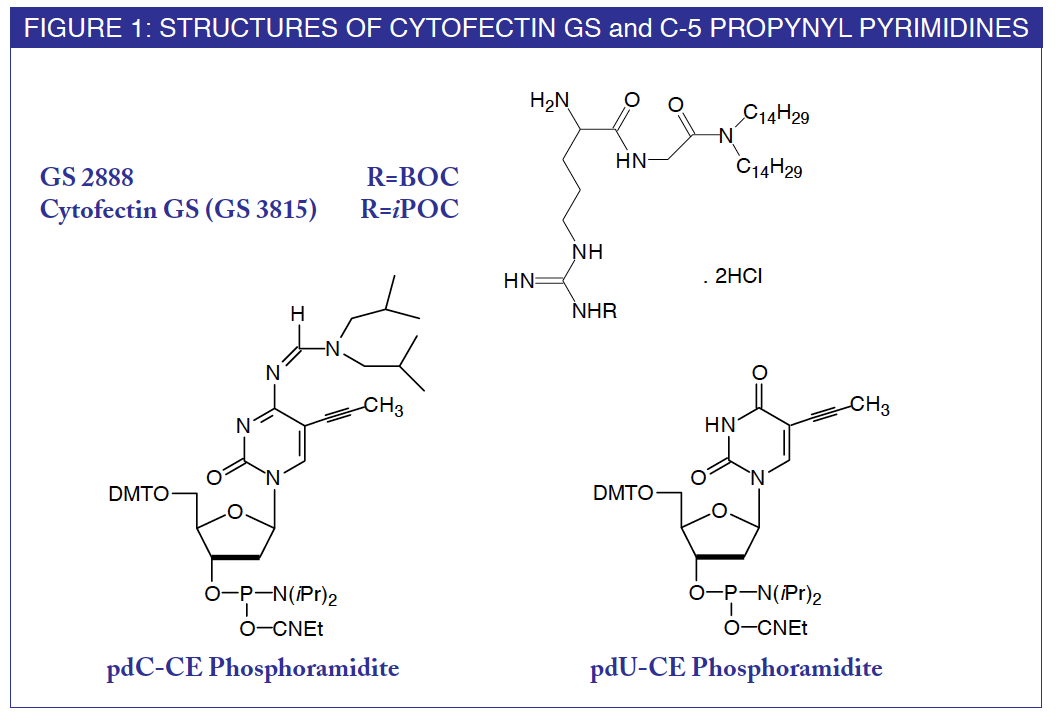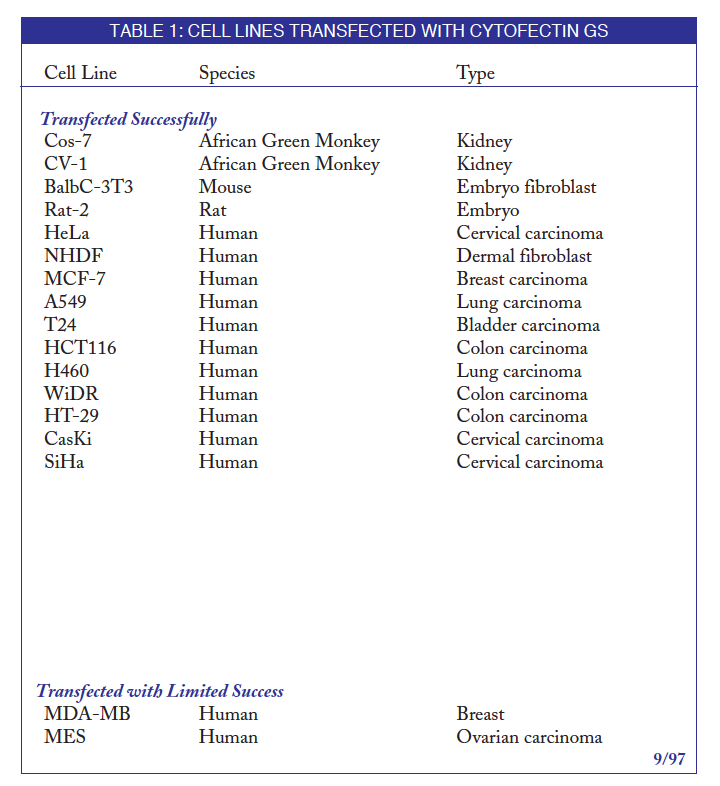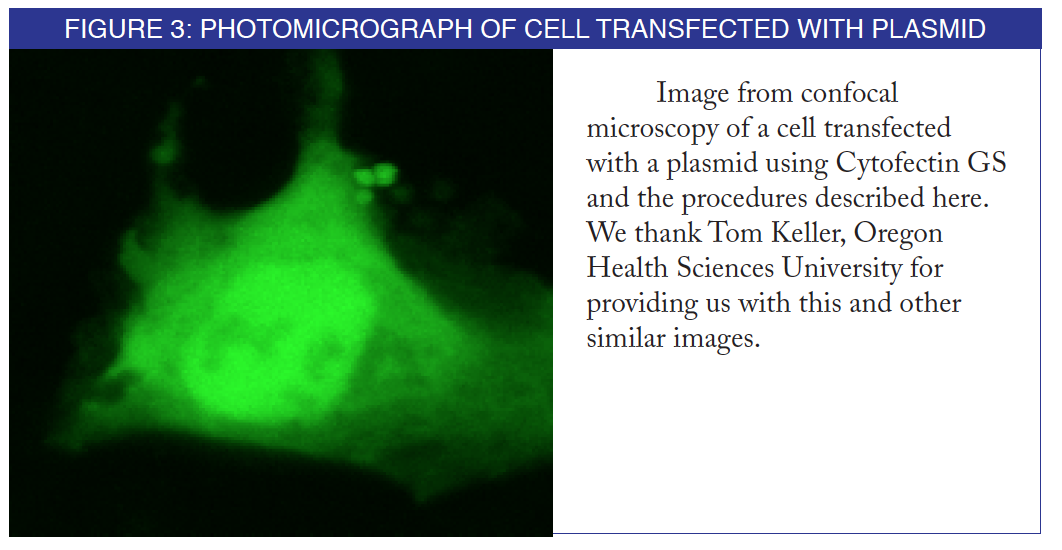Glen Report 10.13: Cytofectin GSV Transfection Protocol
Introduction
Introducing DNA into cells with cationic lipids can be a powerful tool for examining the roles of genes in biological systems. For example, antisense oligonucleotides, delivered into cells with cationic lipids, have become standard tools for the elucidation of gene function.1,2 Until now, the problems associated with lipid-mediated delivery have been poor transfection efficiency and/or high levels of cytotoxicity. Cytofectin GSV alleviates both of these problems, delivering DNA efficiently to a broad spectrum of cell lines in the presence of serum containing growth media. Cytofectin GSV is a formulation of two moles of a cationic lipid, cytofectin GS, with one mole of the zwitterion L-a dioleoyl phosphatidyl-ethanolamine (DOPE*). Cytofectin GSV delivers DNA with or without serum. (Cytofectin GS corresponds to Gilead Sciences' GS 3815 which is a more stable formulation of the cytofectin GS 2888 (Figure 1) reported by Lewis, et al.3) Like GS 2888 vesicles, Cytofectin GSV can deliver plasmids as well as oligonucleotides. It should be noted that Cytofectin GSV works best with adherent cells and performs less well with cells grown in suspension culture.

The following is a protocol for transfection of antisense phospho-rothioate oligodeoxynucleotides using Cytofectin GSV into adherent cells grown on 100 mm plates (Figure 2). It was provided by Gilead Sciences where this system has been usedfor gene inhibition with C-5 propyne antisense oligonucleotides in low nanomolar concentrations.3-7 Gilead's contribution to this project is gratefully acknowledged.
Stability and Storage Conditions
- Store Cytofectin GSV at 4°C; mix well before use. It is stable for at least three months. For a longer term, store at -70°C. Cytofectin GSV is a liquid formulation of 2 moles of the cationic lipid, Cytofectin GS, and one mole of DOPE and shipped as a 2 mg/mL lipid in sterile water. The formula weight of Cytofectin GS is 782 and of DOPE is 744.
- Store oligos at -20°C. If the oligo will be used frequently, store it at 4°C.
Determination of Appropriate Oligo and Lipid Concentrations
Other transfection reagents only work in a narrow range based on the final charge ratio of the lipid/DNA complex. Cytofectin GSV, however, works across a much broader range of charges, eliminating the need for numerous calculations. We suggest beginning with 2.5 µg/mL of lipid for transfecting oligos and 10 µg/mL for plasmid transfections, and titrating the oligo within the ranges below.
- Oligo concentration range: 500 nM-1 nM depending on the potency of the oligo used.
- Phosphorothioate oligos: 500 nM-100 nM
- Propyne modified oligos: 30 nM-1 nM
- Plasmid concentration range: 1.0 - 2 µg/mL.
- Lipid concentration range: 1.0 - 10 µg/mL.
Plating cells
In 100 mm plates, plate cells so they achieve 60-80% confluence on the day of transfection.
Oligo/Lipid Complex-4 mL Final Volume
- Eppendorf tubes. (The oligos do not need to be kept sterile.)
- Transfer the tubes to a tissue culture hood, and add Opti-MEM media (Life Technologies Inc.) to each tube to a final volume of 200 µL (i.e., to 4 µL of a 10 µM oligo stock, add 196 µL Opti-MEM). Opti-MEM can be replaced by non-serum containing minimum essential medium (MEM).
- Aliquot the lipid (in a tissue culture hood) into a 12-well polystyrene tissue culture plate.
Note: Use of polystyrene plates is essential as the oligo/lipid complex binds to polypropylene.
- Add Opti-MEM to each well to a final volume of 200 µL (i.e., to 10 µL of a 1 mg/mL lipid stock add 190 µL Opti-MEM).
- Add 200 µL of oligo/Opti-MEM mixture in the Eppendorf tube from Step 2 to the corresponding well in the 12-well polystyrene tissue culture plate containing the lipid/Opti-MEM mixture.
- 200 µL oligo/Opti-MEM
- + 200 µL lipid/Opti-MEM
- = 400 µL
- Incubate 10 to 15 minutes at RT.
- Add 3.6 mL complete growth media (10% FBS and antibiotics do not affect transfection efficiency) and mix well for a total transfection volume of 4 mL.
Transfection
- Remove media from cells and replace with the 4 mL of the oligo/lipid transfection mixture. Do not wash cells at any time with PBS or Tris buffered saline before or after the addition of the transfection mix as this may affect transfection efficiency.
- Incubate transfection mixture with cells for 4-6 hours, then add a further 4 mL of complete media. Do not remove the lipid/oligo transfection mixture after 4-6 hours unless intolerable toxicity is observed.
- Dose for 24-48 hours before analyzing cells or preparing protein extracts. Exact timing of the experiment will depend on the t1/2 of the protein of interest. The t1/2 of phosphorothioate oligos is ~35 hours; phosphodiester oligos have a t1/2 of 20 minutes.
In Table 1, we have listed cell lines which have been successfully transfected with Cytofectin GSV.

Preparation of Cytofectin GS Vesicles(1)
Materials
a. Cytofectin GS: (Glen 70-3815-70)
b. 1,2-Dioleoyl-sn-glycero-3-phosphoethanolamine (DOPE) in CH3Cl (10 mg/mL): Avanti Polar Lipids, Inc., Alabaster, Alabama, # 850725* or equivalent.
Method
- To one tube containing 2 mg of cytofectin GS 3815 lipid add 0.1 mL of a 10 mg/mL solution of DOPE in chloroform. Vortex to dissolve Cytofectin GS. This will yield a final molar ratio of Cytofectin GS to DOPE of 2:1.
- Evaporate the chloroform in a speed-vac or under an argon stream to form a thin lipid film in the tube.
- Add 1.5 mL sterile water to the film to form a lipid suspension. Vortex the suspension for 5 min. This yields a final lipid concentration of 2 mg/mL.
- Freeze-thaw the tubes 6 times (dry ice/37°C bath).
- Store lipid preparation at 4°C. Material retains activity for ≥3 months. Also material can be stored at -70°C and will retain activity for ≥1 year. -
- The liposomes can be used directly or sized by filtration through a polycarbonate membrane (50-200 nm pore sizes; Liposofast; Avestin, Ottowa, Canada). 100 nm vesicles were found to be optimal in studies by Gilead Sciences.
Uptake analysis of fluorescent oligonucleotides in African green monkey kidney cells (CV1), at Gilead Sciences, showed that an unsized formulation, prepared by the freeze-thaw method, of 2:1 (mole:mole) ratio of Cytofectin GS to DOPE was optimal for delivery. This formulation is referred to as Cytofectin GSV (Glen 70-3815-79).
* Avanti Polar Lipids, Inc.
700 Industrial Park Drive.
Alabaster, AL 35007.
Phone: 1-800-227-0651 or 205-663-2494.
Fax: 1-800-229-1004 or 205-663-0756
Email: avanti@quicklink.net
References:
- Wagner, R. W. Gene inhibition using antisense oligodeoxynucleotides. Nature, 1994, 372, 333-5.
- Wagner, R. W., Matteucci, M. D., Lewis, J. G., Gutierrez, A. J., Moulds, C. and Froehler, B. C. Antisense gene inhibition by oligonucleotides containing C-5 propyne pyrimidines. Science, 1993, 260, 1510-3.
- Lewis, J. G., Lin, K.-Y., Kothavale, A., Flanagan, W. M., Matteucci, M. D., DePrince, R. B., Mook, J. R. A., Hendren, R. W. and Wagner, R. W. A serum-resistant cytofectin for cellular delivery of antisense oligodeoxynucleotides and plasmid DNA. Proc. Natl. Acad. U.S.A., 1996, 93, 3176-3181.
- Flanagan, W. M., Su, L. and Wagner, R. W. Elucidation of cell cycle gene function using C-5 propyne antisense oligonucleotides. Nature Biotechnology, 1996, 14, 1141-1145.
- Flanagan, W. M., Kothavale A. and Wagner, R. W. Effects of oligonucleotide length, mismatches and mRNA levels on C-5 propyne-modified antisense potency. Nucleic Acids Research, 1996, 24, 2936-2941.
- Coats, S., Flanagan, W. M., Nourse, J. and Roberts, J. M. Requirement of P27kip1 for restriction point control of the fibroblast cell cycle. Science, 1996, 272, 877-880.
- St. Croix, B., Florenes, V. A., Rak, J. W., Flanagan, M., Bhattacharya, N., Slingerland, J. M. and Kerbel, R. S. Impact of the cyclin dependent kinase inhibitor P27kip1 on adhesion-dependent resistance of tumor cells to anticancer agents. Nature Medicine, 1996, 2, 1204-1210.
Note:
Cytofectin GS and C-5 propynyl pyrimidine nucleoside phosphoramidites are made available by Glen Research under exclusive license from Gilead Sciences.
PRODUCT INFORMATION
Cytofectin GS has been discontinued
- Glen Report 10.11: DCI - A Logical Alternative Activator
- Glen Report 10.12: Preparing Oligonucleotides for Antisense Experiments
- Glen Report 10.13: Cytofectin GSV Transfection Protocol
- Glen Report 10.14: New Fluorescent Reagents - TAMRA CPG, Fluorescein-dT
- Glen Report 10.15: Universal Support Replaces Individual Columns
- Glen Report 10.16: Q-Supports Reduce Cleavage Time to 2 Minutes
- Glen Report 10.17: More Novel Monomers
- Glen Report 10.18: Non-enzymatic Ligation of Single-stranded and Duplex DNA



